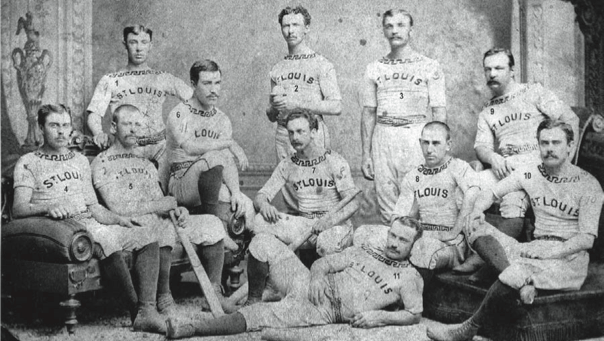Explore this unique New Year’s Eve tradition, probably the oldest continual tradition of European origin in Missouri. Called La Guignolée and pronounced gee-oh-nee, it’s a begging quest for small favors on New Year’s Eve.
Nearly every New Year’s Eve going back to Ste. Genevieve’s settlement in the 1730s and 1740s, the locals gathered in homes, taverns, and billiard halls to sing and dance. It’s called the La Guignolée (pronounced gee-oh-nee) and it’s possibly the oldest continual tradition of European origin in Missouri. Nowadays the descendants of the original French settlers meet every New Year’s Eve to keep traditions alive.
Anna Servaes, Ph.D. in Francophone Studies (the study of French-speaking cultures), provides some historical context. The La Guignolée has a proven history in France going back to the 1600s and was brought here in the 18th and 19th centuries. In addition to Ste. Genevieve, the tradition can be found in places where the French culture has spread, including along the Mississippi in a few select towns, such as Old Mines, Missouri, and Prairie du Rocher, Illinois. It is called La Guiannée at Prairie du Rocher, as it was at Ste. Genevieve before 1935, and La Guillonée at Old Mines. Other variants exist, too.
Caroling as we know it (think figgy pudding) and La Guignolée are begging quest songs, singing in hope of small gifts of food or spirits, or both.
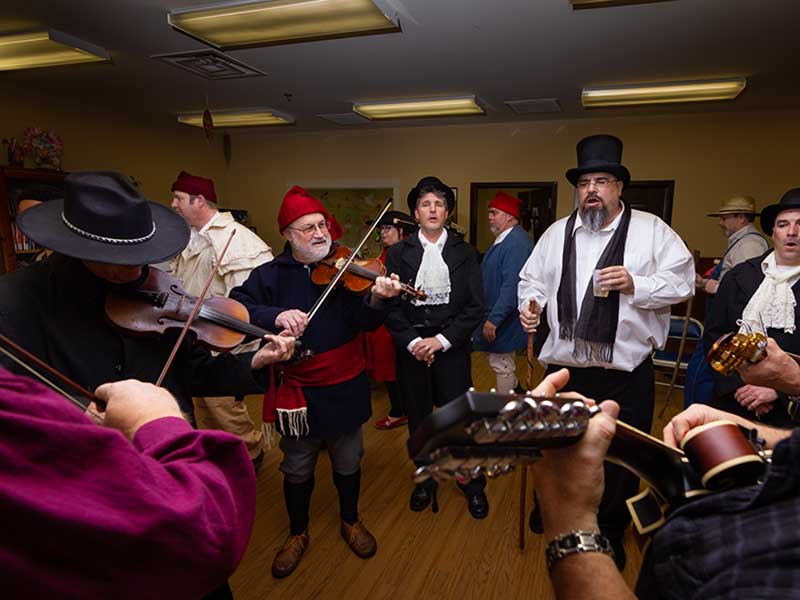
It was New Year’s Eve, and I was driving across the entire state of Missouri. I was trying to get into this obscure French tradition while my family was relaxing and power eating. Maybe I was a little jaded as I was getting lost in the outskirts of Ste. Genevieve after my five-hour car ride.
I pulled into the Legion Hall parking lot to meet my contact in the Guignolée troupe, Pete Papin. I clambered into his truck for a Guignolée interview. Pete is an older gentleman with some seriously strong ties to Ste. Genevieve. Pete’s father, Art, was fluent in French and served in World War I as a French translator for the American Army.
As we pulled out of the parking lot, I figured now was a good time to start asking questions. “So uh, I’ve got some questions for you about the Guignolée. Do you think …”—“Now everything you need to know is right here,” Pete interrupted and held up an audio tape for me to see before popping it into the car stereo. Intrigued, I listened as the sounds of a 1950s recording came over the car speakers. A producer introduced a group of the La Guignolée singers, including Mr. Papin (Pete’s dad) as the soloist and leader.
The song on the crackling old recording was sung in authentic Paw Paw French (the endangered dialect traditionally spoken here). Just like food, language blends with those of other cultures that it comes into contacts with, such as the Spanish, Native American, German, and African cultures that were present at Ste. Genevieve.
The use of the local dialect of Paw Paw French which was still spoken as little as thirty years ago has now become rare. Pete told me he remembers hearing folks speak it when he was a boy but that those days are long gone. “Back in the 50s, there was a trend of French Canadians coming down here to visit and find long-lost relatives.”
We dropped by his place to pick up an old French-style pot pie he had cooling for the evening, made from an ancient family recipe, he said. As we ran the errand, neighbors poked their heads out their doors and yelled out things like, “Hey, Pete! Ready for tonight?” We drove to the Legion Hall and he told me more about his family’s involvement with the Guignolée. “It’s been done going back as far as I can remember. There was a time when it was seen as un-American and was suppressed by local officials and the like, but we were able to outlive all that negativity. My son has become the ring leader of sorts, so you’ll have to talk to him.”
At the Legion Hall, a growing crowd of costumed participants and well-wishers were gathering. Pete’s son, Mike, is something of a gentle giant, a friendly man who loves his town and the people in it. He was the human epicenter for all the activity around him. Even so, he made time to talk with me, a scraggly, caffeine-addled reporter with camera bags and recorders strapped to my back and chest.
After talking to Mike, I shout at the group, “Gather together here and let me get a picture!” ‘Clack’ goes the shutter, and the group broke and headed into the bar attached to the Legion Hall to have the first big sign of the night. Mashing themselves into the crowded bar, the group clad in costumes struck up an aged tune to the screeching of steel-stringed fiddles. The group marched slowly counterclockwise around Mike, Pete, and a few musicians on fiddle, guitar, and mandolin, who were huddled in the middle of the room.
The music paused, and Mike stood tall as he belted out his solo:
“Nous supplions la compagnie de vouloir bien nous excuser
Si nous avons fait quelque folie, c’était pour nous désennuyer.
Une autre fois, si nous prenons garde, si nous avons l’honneur de revenir.”
Which translates roughly:
We beg the company to excuse us,
If we made some madness, it was because we were bored.
Another time, if we take care if we have the honor to return.

And after one more chorus, it was over. The whole room cheered, and beer flowed like water to the troupe amid much back-slapping. After another ten or so minutes everyone started climbing into the rented bus outside. Mike’s wife, Jerri, stood by the door with a clipboard asking what everyone’s poison of choice was for the next stop. “I’ll have a Bud,” I said.
Stepping onto the bus, I noticed everyone’s outfits and remembered something else Anna had said—that throughout its long history the town has officially been Spanish, French, and American territory. Other ethnic groups have also left their footprint on the local culture, including German immigrants and Native Americans who traded with and formed alliances through marriages with early French settlers for mutual protection against larger more aggressive tribes. All of these cultures, French, German, Spanish, and Native American, have melted together here while somehow staying distinct, not unlike when you take all your leftovers from the week and bake them into a casserole, with distinct flavors yet all together.
Outside the first stop, a nursing home, the group gathered.
“It’s really important to the older folks to see us out doing the Guignolée and keeping the tradition alive,” someone noted. “They grew up with it, and some of them used to participate. Most importantly, it shows them that they’re still a part of the community.”
All the residents were decked out in New Year’s Eve finery, and the Guignolée troupe went weaving through the tables, singing. At the end of the song, one of the singers nudged me and pointed over to a female resident who had a bottle of red wine. “This is special, look at this.” She walked to Mike and handed him the bottle. “Most of these residents lived here all their lives, and their families have participated in the Guignolée for centuries. It’s an old, old custom to give wine to the singers!”
Next, we visited a school with local families and children, then another retirement home or two. By this point, the mood on the bus was downright festive. Every time the bus slipped around a curb, all hands flew into the air as if we were on a roller coaster with everyone whooping and hollering.
The bus pulled into the older part of town, where the Guignolée has traditionally been done. Before the times of motorcars and buses, the troupe had to walk in the chilly night air.
While walking down the street, I saw ahead a well-maintained building gray with age. It seemed older and out of place among the row of buildings from the 1800s. As we stepped up onto the porch of the 1770 Bolduc-LeMeilleur House, curators stood waiting by the door wearing big smiles. I saw the building was made of massive solid timbers, and the floorboards were nearly six inches wide. Listening to the song that was almost certainly sung in this very room as far back as the 1770s by descendants of those original singers, the song ceased to be something that was sung for a good time but became more of a ceremony to honor ancestors and tell them, “We’re still here, and we’re still your children.”
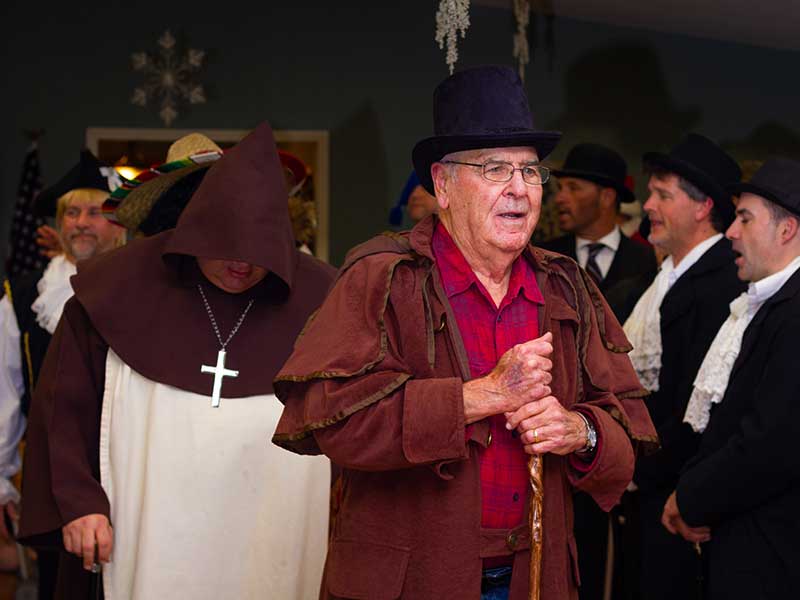
Daniella Michaels, in her early twenties and one of the youngest participants, told me “Being in there, singing the Guignolée almost felt like a religious experience. Our small gathering was loud with our song, and it made the dimly lit space mesmerizing. Knowing the depth of the generations made it easy to be astounded, especially knowing some members have been performing La Guignolée for upwards of seventy years.”
Next, we walked back up to the Hotel Audubon to give another good sing at the packed hotel restaurant, where specialty French dishes were being served all night. I had the bouillabaisse, and it had some of the biggest scallops I’ve ever seen. Afterward, I sat with Mike and chatted about the evening so far. We walked onto the dark street to discover we were alone. “Dude, where’s the bus?” I said. In all of the festivities and confusion, the group had left without us. How you could misplace a towering guy like Mike, who was also the soloist, will forever be a mystery to me. We caught up with the group down the street.
As we caught up with the troupe, I thought about something else Anna had said, traditionally, the King’s Ball, a formal dance for the whole community, was held on January 6th. The words of the Guignolée betray its ties to that celebration. In the song, the singers comically ask for food items like, “a backbone of pork ten feet long.” Food was collected all over town to be saved for the King’s Ball days later.
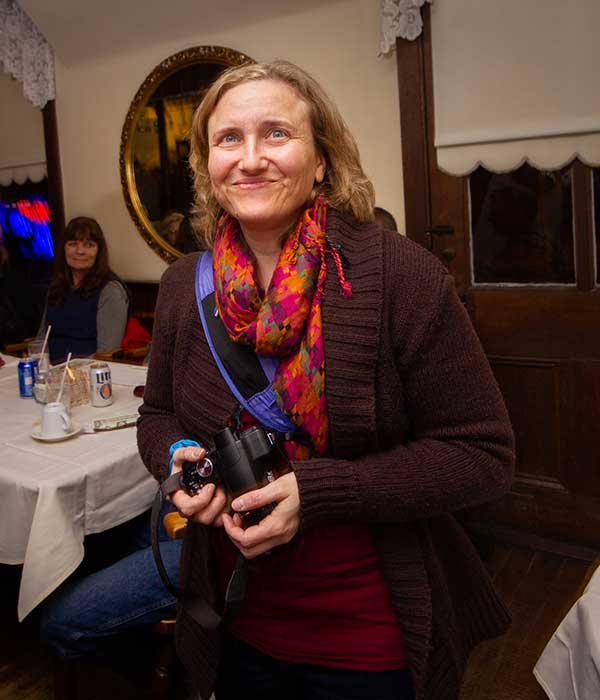
But the Guignolée had another important function, too. The next line in the song, “We only ask for the eldest daughter, we will make her eat well, we will show her a good time!” So basically, the eldest daughter and her entire family were invited to the formal dance that was the beginning of the winter social season, after harvest and before planting. Families welcomed Guignolée singers with candles and lights left on, much as trick-or-treaters are welcomed with lights left on today. I can’t imagine any other time it would be acceptable to wander up intoxicated to your crush’s house in the middle of the night with your best mates and demand her father give her to you. With this in mind, we made our last stop.
The grand finale was crashing a local wedding reception on the other side of town. With fiddles blaring and feet stomping, we really gave a good show to finish out the night. The bride ran up and threw her arms around members of the group. It was a perfect ending. Afterward, we headed back to the Legion Hall for Chicken Scratchers, a local delicacy, I’m told. I picked at my boiled chicken foot and watched the singers.
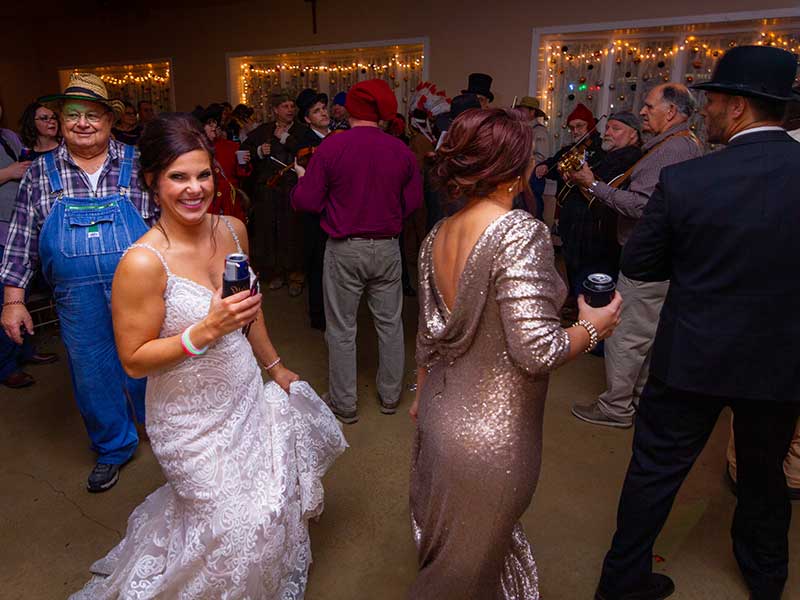
Historian and musician Michael Ruch, Ph.D., is doing everything he can to catalog the traditions of the previous generations. Michael has been working with local legend and fiddle player Quentin Huck, age eighty-six, to preserve as much of the old Paw Paw French music tradition as possible. “Quentin and I both know that traditions like this need to be passed on before people pass on.” The coming together of remnant descendant French locals and historically minded people like Michael and Anna means that everyone was at the La Guignolée for absolutely the right reasons.
La Guignolée isn’t a show put on for tourists with cameras. The people who participate aren’t doing it for you or me but rather because their parents did it, and they did it because their parents did it, and the same going back hundreds of years. Vive La Guignolée!
Q&A with Mike Papin

Tell me about the Guignolée.
My dad’s dad was in charge of it, and my dad and I kind of took it over in 1991 from the previous organizer. I can remember as a kid my grandpa singing it in town. I was in the service from 1986 to 2001, so when I got out, I got into it and kind of took it over. I think there was a dormant period, but it was in living memory the whole time and was done in homes. During World War II, there was an all-women’s La Guignolée because all the men were at war.
Do you have to be a French descendant to join in?
It may have been that, back in the day, you had to be a descendant of the French and be living in town. We’re not sure, but we’re so mixed in with other ethnic groups like the Germans and whatnot, so now we’re not really concerned with genealogy. We’re mainly concerned about people just showing interest.
What does the Guignolée mean to you?
It’s been a tradition in my family forever, and as kids, we’d listen to the old 50s recording of my grandpa. He was a better singer than I am. I remember in grade school, at one time, he was the oldest living French Canadian living in the United States. I remember they had a French Canadian TV crew come down and interview him. The year before my grandma died at ninety-four, I got to sing the solo for her in the nursing home. I promised her I’d keep the Guignolée going as long as I could, and that’s a promise I want to keep. Here are some tips on La Guignolée in Ste. Genevieve, if you go, you’ll want to visit here as well.
Related Posts
July 13, 1852
Birthday of George "Grin" Bradley. On July 15, 1876 he threw the first no-hit, no run game in major league history.
Swing Across This 88-Year-Old Suspension Bridge
The Auglaize Bridge—better known as the Big Swinging Bridge—hangs over the meeting point of Grand Auglaize Creek and Lake of the Ozarks. The bridge was built in 1931—the same year Union Electric completed Bagnell Dam to create the Lake of the Ozarks.

